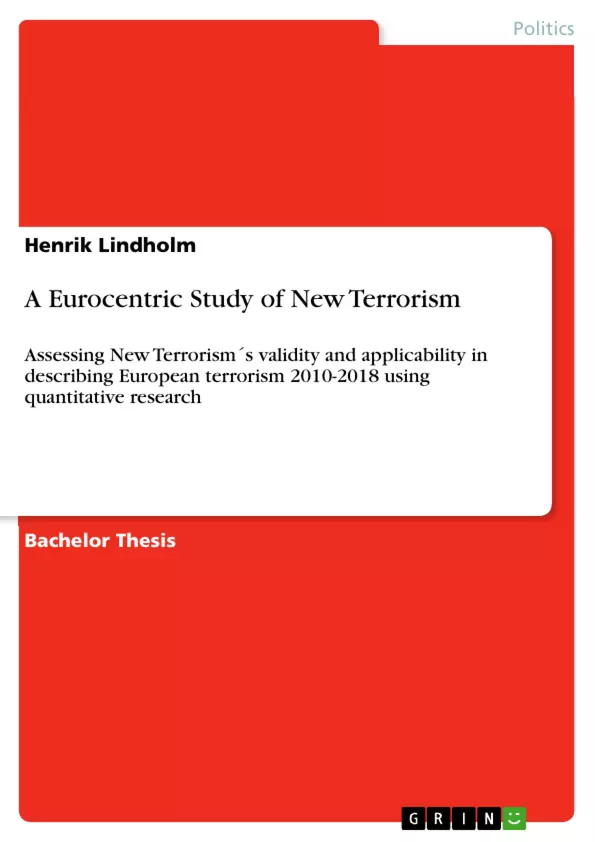New Terrorism has been a highly regarded theory in the field of terrorism since the late 1990s, but how accurate is it in regards to European terrorism in 2010-2018? Are terrorists more lethal, primarily religious, part of transnational and decentralized organizations, and are they using CBRN-weapons? This paper uses a quantitative study, with a descriptive and retroductive approach, of all terror attacks in Europe 2010- 2018, to examine New Terrorisms’ validity, and propose possible changes to the theory.
I find that New Terrorism is partly correct. Terror groups are primarily transnational and non-hierarchical and lethality is higher than in the early 90s, although less so in Western Europe. Separatist groups are however found to be the most common type of movement, followed by ideological movements – responsible for 4 and 2 times as many terror attacks as religious groups. Likewise, the potential threat of terrorists using CBRN-weapons for mass destruction is found to be incorrect. Based on this, New Terrorism 2.0, Europe edition is proposed. Stating that separatist and ideological groups are the most common, lethality is high (but less so in Western Europe), organizations are primarily transnational and non-hierarchical, and the risk of terrorist using CBRN-weapons is low in contemporary European terrorism.
Inhaltsverzeichnis (Table of Contents)
- 1 INTRODUCTION.
- 1.1 BACKGROUND..
- 1.2 RESEARCH QUESTION AND PURPOSE.
- 1.3 STRUCTURE........
- 2. THEORETICAL FRAMEWORK.
- 2.1 TERRORISM.
- 2.2 NEW TERRORISM...
- 2.2.1 Type of Movement.
- 2.2.2 Lethality.
- 2.2.3 Structure.
- 2.2.4 CBRN-Weapons.....
- 2.3 HYPOTHESES.
- 3. METHODOLOGY
- 3.1 RESEARCH DESIGN.
- 3.2 DATA COLLECTION..
- 3.3 DATA ANALYSIS..
- 4. RESULTS.
- 4.1 Type of movement..
- 4.2 Lethality...
- 4.3 Structure..
- 4.4 CBRN-Weapons...
- 5. DISCUSSION
- 5.1 TYPE OF MOVEMENT.
- 5.2 LETHALITY.
- 5.3 STRUCTURE.
- 5.4 CBRN-WEAPONS.
- 5.5 EUROPEAN TERRORISM AND NEW TERRORISM 2.0, EUROPE EDITION.....
- 6. CONCLUSION.............
Zielsetzung und Themenschwerpunkte (Objectives and Key Themes)
This research paper examines the accuracy and applicability of the theory New Terrorism in relation to European terrorism between 2010 and 2018. The paper analyzes terrorist attacks in Europe during this period to evaluate the validity of New Terrorism's key tenets and proposes potential modifications to the theory.
- Examining the validity of the New Terrorism theory in the context of European terrorism.
- Analyzing the characteristics of European terrorist groups, including their type, lethality, structure, and use of CBRN-weapons.
- Identifying the prevalence of different types of terrorist movements in Europe, such as separatist, ideological, and religious groups.
- Evaluating the level of lethality in European terrorism and comparing it to past trends.
- Assessing the organizational structures of terrorist groups in Europe, particularly their transnationalism and hierarchy.
Zusammenfassung der Kapitel (Chapter Summaries)
The paper begins with an introduction that provides background information on terrorism, outlines the research question and purpose, and details the paper's structure. It then presents the theoretical framework, defining terrorism and exploring the key elements of the New Terrorism theory, including type of movement, lethality, structure, and the potential use of CBRN-weapons.
The paper delves into the methodology employed in the research, explaining the research design, data collection methods, and data analysis techniques. The results section presents findings on the type of movement, lethality, structure, and use of CBRN-weapons in European terrorism.
The discussion section analyzes the results in detail, providing insights into the prevalence of different types of terrorist groups, the level of lethality, the organizational structures of terrorist groups, and the lack of evidence for the use of CBRN-weapons. It also proposes modifications to the New Terrorism theory based on the findings, resulting in a new framework called New Terrorism 2.0, Europe Edition.
Schlüsselwörter (Keywords)
The research focuses on the core concepts of New Terrorism, European terrorism, CBRN-weapons, religious terrorism, lethality, and separatist terrorism. The paper utilizes a quantitative approach to examine the accuracy of the New Terrorism theory in describing contemporary European terrorism.
- Citation du texte
- Henrik Lindholm (Auteur), 2020, A Eurocentric Study of New Terrorism, Munich, GRIN Verlag, https://www.grin.com/document/907861



